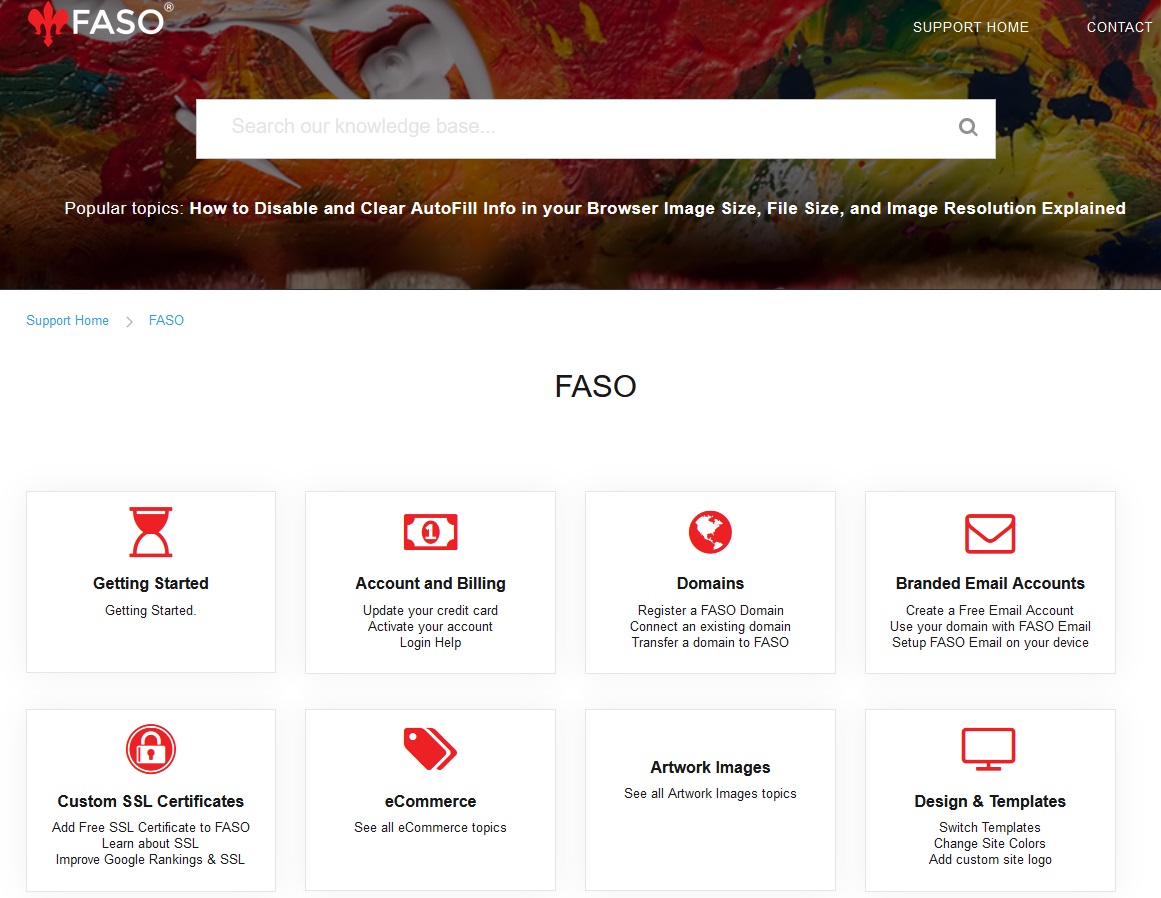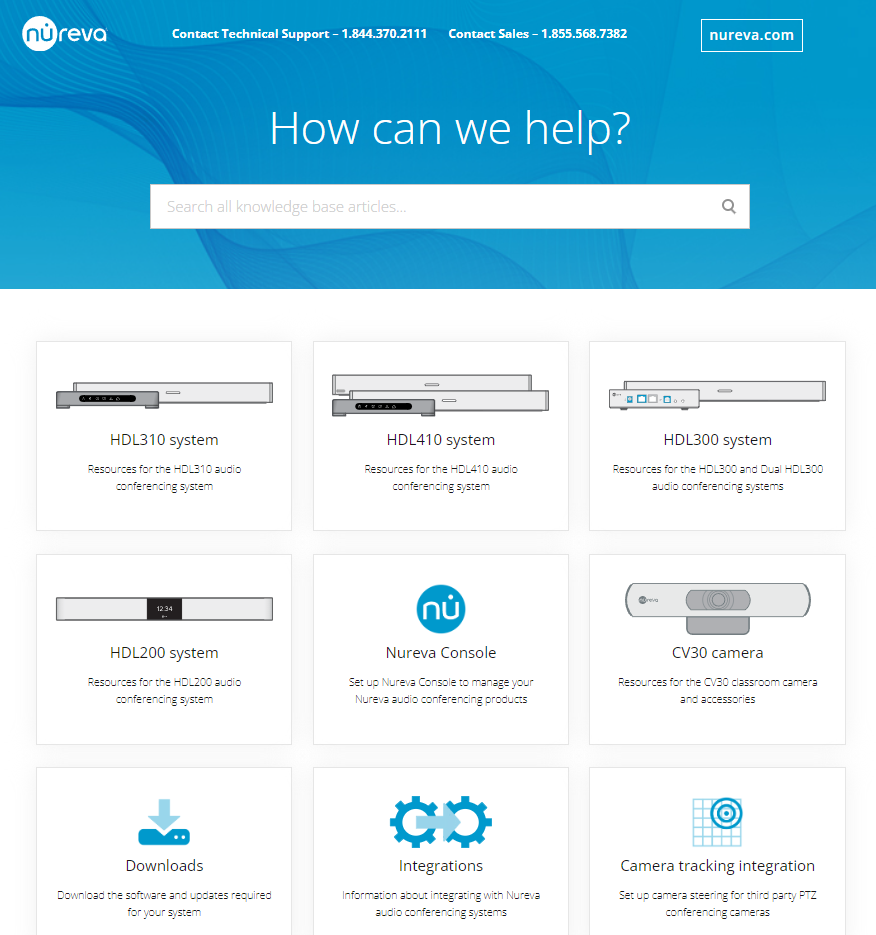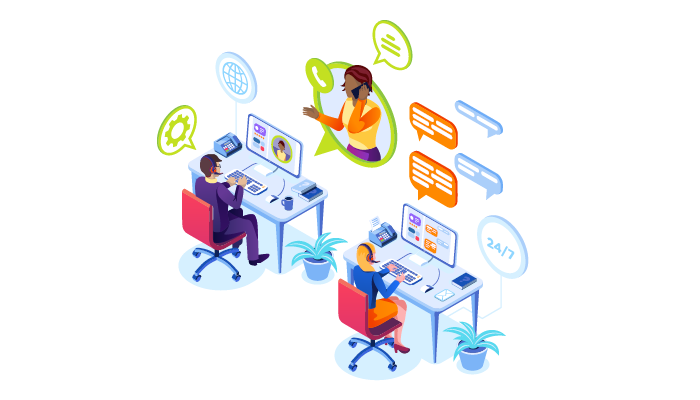Modern customer service and support is all about letting the customer help themselves.
Whether they’re looking to solve a quick problem, overcome a larger challenge, or take their journey to the next level, it’s your job to equip them with the knowledge and resources they need to accomplish their goals.
And, it’s your job to present these resources effectively and efficiently so your customers can get what they need to continue on toward success.
This is where your digital help center comes in.
What is a Help Center?
A help center is a digital customer support hub that offers resources to help users solve problems, overcome challenges, and utilize a product or service to the best of their ability.

As a centralized platform for all things customer support, a help center will typically include a variety of tools and resources, such as:
- A customer-facing knowledge base offers helpful articles, how-to guides, FAQ pages to support users at all stages of their journey.
- Resource libraries offer instructional videos, webinars, and other more structured educational material for users to learn from.
- Community forums allow users and company reps to engage in discussions focused on topics related to the company’s product and services — and the industry as a whole.
- Contact and support ticket forms provide ways for users to escalate support requests to live representatives with ease.
While each element of your help center is its own entity, incorporating them onto a single platform ensures a cohesive and comprehensive experience whenever your customers are in need of support.
Why You Need to Offer a Help Center
By today’s standards, both consumer and provider see digital help centers as a necessary part of the modern customer experience.
And with very good reason.
1. Enable and Empower Your Customers via Self-Service
Offering self-service options to your customers isn’t about pawning responsibility off on them so your support staff doesn’t have to do anything.
On the contrary, providing a comprehensive help center, which includes an intuitive self-service portal, enables and empowers your customers to take matters into their own hands. It allows them to solve their own problems, overcome their own difficulties, and accomplish more than they’d ever anticipated doing without hands-on assistance.
In the immediate sense, this means they can continue making progress with your product or service on their own terms — and won’t have to wait for your support staff and other resources to become available.
Thinking of the bigger picture, your customers will become more and more empowered to solve their own problems over time. This empowerment will continue, even as things potentially become more challenging as they advance in their journey and aim toward higher goals.
2. Increase Customer Engagement, Success, and Retention
Offering helpful content within your help center is an effective way to keep your audience onboard — and keep them motivated toward achieving their goals.
(In fact, brands like Hack the Box have seen both a decrease in customer churn and an increase in user engagement upon introducing their customer-facing help center.)
For one, you’ll avoid losing those who would otherwise churn the first time they encounter a problem. If they can always find a solution to the issue at hand, they’ll be much more likely to continue reaching toward their goals.
Moreover, your help center’s content can provide guidance as to the “next step” for your users to take in their journey, or make them aware of your product or service’s more advanced features and use cases. Either way, it gives them a clear reason to continue engaging with your brand.
3. Reduce Support Costs
As we said above, making your support staff’s lives easier isn’t the main reason to offer a help center to your customers.
…but it is a pretty substantial byproduct of doing so.
By offering self-service options as a first line of defense for customer support issues, you’ll inevitably cut down on the number of service tickets your team receives.
Case in point:
- Canopy reduced their support tickets by 75% with their new help center
- KaarbonTech support tickets dropped by 70% thanks to Helpjuice
- Fujitsu reduced phone calls and email tickets by 30% with Helpjuice
Such drastic decreases in support staff workload will lead to an equally drastic reduction in resource consumption — and decrease the risk of overextending your staff when ticket spikes occur. In turn, you’ll have more resources available to invest into initiatives that do require hands-on efforts from your support staff.
On that note…
4. Scale Service and Support Efforts
Your digital help center is scalable by nature in a few ways.
For one, it eliminates the problem of bandwidth — allowing you to serve thousands of customers (and thousands more over time) without interruption. This certainly beats having to hire additional service reps as your audience grows larger over time.
Your help center allows you to provide differentiated support to your growing audience based on their needs. As we’ll discuss, this includes catering to users that speak different languages, have different abilities, and otherwise require additional assistance.
Finally, it allows you to supercharge your support initiatives across the board. This could mean creating more and better content, enhancing your hands-on customer support practices…basically, doing whatever’s needed to better support your customers.
Learn how Shipt scaled their customer support efforts in multiple ways with Helpjuice.
5. Enhance Your Customer Experience and Brand Reputation
Your help center is not an “extra” thing that operates separately from the rest of your brand.
Rather, it’s an extension of your brand, and of the experience you provide your customers.
In this regard, your help center provides additional opportunities for you to deliver more and more value to your customers and enhance their experience with your brand.

While this is clearly good for your customers, it’s also great for your brand’s reputation — and for your business. As Zendesk recently discovered, 60% of consumers have actually made purchases based solely on the level of support they expect to receive.
Yes, your customers basically expect you to have a help center at this point. But, you can use it to exceed their expectations in ways that help them succeed and showcase your true dedication to their success.
That is what will keep them around for the long term.
Features of an Effective Help Center
Your help center needs to be designed and implemented properly in order to deliver value to your customers.
Here are the key features your help center should include.
Comprehensive Information
The whole point of your help center is to provide critical information to your customers that enables them to accomplish their goals, solve problems, and make progress in their lives.
To that end, you need to ensure the information you provide within your help center is as comprehensive and thorough as necessary.
Generally speaking, this includes information about…
- Your primary products and/or services
- Your industry and related topics
- Your policies and other customer service-related info

As shown above, many healthcare practices adeptly manage knowledge by offering articles and other informational content on the various diseases and ailments they treat within their help centers. This allows patients to prepare for in-person appointments, and to conduct additional research after consulting with specialists in the practice.
User-friendly Interface and Navigation
Your digital help center should be easy to use and navigate — even when your users are rather frustrated.
(Which, if they’re currently in need of help, they likely will be.)
Needless to say, you don’t want your help center to add to your user’s frustration. Ideally, you want them to be soothed not just by the information you provide, but by the ease in which they were able to receive it.
Key principles of proper help center design include:
- Intuitive layout and organization
- Effective search functionality and simple on-screen navigation
- Consistently branded appearance
The easier it is for your customers to use your help center, the more they’ll rely on it as a first point of touch when in need of assistance.
Multimedia Support
Providing multimedia support within your help center allows you to accomplish a few key things:
For one, it enables you to deliver critical information in the most effective way possible. For example, video can be used to showcase tacit knowledge that is difficult (or impossible) to communicate via text.
Or, it may just be more engaging for certain info to be presented in a certain way:

You can use multimedia to cater to different user preferences and learning styles — ensuring all users can quickly digest the information they need in the way they learn best.

Whether looking to repurpose or expand on existing content, liberal use of multimedia helps your users solve their problems efficiently — and keeps them maximally engaged throughout the process, as well.
Contact and Escalation Options
While your customers will ideally be able to solve most of their issues on their own, there will come times when they’ll need to get in touch with your support staff.
And doing so right from your help center should be as simple as possible.
You also want to use these moments to double-check that the user can’t solve the issue on their own. At the very least, you’ll have some preliminary info to go on whenever a ticket is submitted.


As shown above, Loomis uses a widget to narrow down users’ needs first, then helps them connect to an agent via email or chat. That way, both parties come to the engagement with a clear idea of the situation at hand — and your team can get a jump on solving the issue with quickness.
Feedback and Data Collection
Lastly, your help center should allow your users to provide feedback — both with regard to your help center, and to your brand as a whole.

This gives your customers the opportunity to make their voices heard — and to ideally see their preferences reflected in your company’s future efforts. For your team, the feedback you collect will provide clear guidance as to how to improve your products, services, and support efforts moving forward.
Key Steps to Creating a High-Impact Help Center
Putting together a comprehensive, high-impact help center is an involved process that happens not all at once, but over time.
(In fact, your help center should always be evolving in some way or another. More on this later.)
For those just getting their help center up and running, here’s what the process should look like.
1. Define Your Goals
Your first order of business is to define exactly what you hope to accomplish by creating a digital help center.
Here, you want to think about both your customers and your company.
On the customer’s side of things, some goals to consider include:
- Improving self-service success rate
- Reducing self-service resolution time
- Increasing product adoption rate
For your support staff and business, your goals might include:
- Reducing customer service tickets as well as minimizing customer support emails
- Minimizing time-to-resolution
- Increasing brand reputation and trust
Basically, you don’t want to create a help center just because you know you need one.
Yes, offering even a basic help center is likely better than offering none at all. But, by setting clear goals from the start, you can develop your help center in a way that works best for both your customers and your business.
2. Develop Content Strategy & Structure
You’ll then need to create a strategic, systematic approach for creating and presenting your help center content.
We suggest taking the time to create a style guide here — for a few reasons.
Your style guide need not be too in-depth, and should simply focus on your content’s:
- Tone
- Clarity
- Depth
- Structure
- Formatting
Now’s also the time to develop the hierarchical structure of your help center. An intuitive structure here makes for a streamlined experience for your customers — and makes it easier for your team to edit and add to help center content over time.
Many brands take a product-focused approach to their help center’s structure.

Here, Nureva makes it easy for owners of specific systems to quickly navigate to the appropriate knowledge content.
You might also structure your help center based on user experience levels, use cases, or any other relevant factor.

In any case, the goal is to quickly point the user to the information they need — and communicate it to them just as efficiently.
3. Invest in the Right Help Center Software
While there are a number of excellent help center tools on the market today, you want to be sure the one you invest in is right for your team.
Some of the key things to look for:
- Collaborative Content Creation/Editing: Look for help center software that allows your team to create and edit content collaboratively — both asynchronously and in real-time.
- Customizability: The tool should allow you to customize your help center in terms of content hierarchy, structure, and appearance.
- Navigability: AI-powered search functionality and other navigation assistance ensures your users can find the information they need with ease.
- Accessibility: Make sure your help center software offers accessibility features for your diverse audience.
- Reporting and Analytics: In-depth usage reports will help you make ongoing improvements to your help center — and to your overall customer experience.
Lastly, don’t forget to confirm that your help center software integrates well with your current tech stack, including any ticketing or help desk software you currently use. This not only facilitates smooth workflows and enriches customer experiences but also guarantees alignment with your overarching customer service strategy.
4. Optimize Help Center Design
Next, you’ll need to customize your help center to match your audience’s needs and expectations.
The general rule of thumb is to focus on practicality and accessibility above all else.
(Since your users are coming to your help center for help, there’s no need to get fancy here.)
That said, you do want to customize your help center’s appearance to match your brand’s general theme and aesthetic.


Your on-page content should take on a similarly branded-yet-simple appearance:

Be sure to set up any automated accessibility settings now to ensure they’re applied to all help center content you create moving forward. Before it goes live, your help center should be fully mobile-responsive, accessible to disabled individuals, and localized in language and content for different cultural contexts.
5. Develop and Publish Content
Now, you can finally begin creating your help center content.
To figure out where to start, consult your customer data.
Specifically, consider…
- What topics or issues most commonly appear in support tickets and queries?
- Where do your users tend to get “stuck” most often with your product/service?
- What do your users say is most challenging or difficult about using your product/service?
(Pro Tip: Consult forum posts, user-generated content, and even third-party sources to gain additional insight into your customers’ issues and how they typically try to deal with them.)
From there, look to your team of specialists to determine which topics to focus on, and how to create content around said topics. A collaborative effort here ensures your help center content is comprehensive and accurate — but also skimmable and digestible for your potentially-overwhelmed users.
To scale this step efficiently, many teams complement expert-written articles with short explainer videos using AI UGC, helping users absorb complex workflows faster without increasing content production overhead.
Regardless of who’s creating each page, remember to adhere to the aforementioned style guide at all times to provide a consistent and comforting experience to your audience.
6. Launch and Promote Your Help Center
Once you have a sufficient amount of content ready to go, you can officially launch your help center — and immediately begin promoting it.

On top of announcing your help center via email and social media, make permanent space on your website to drive traffic to it.

Actively promoting your help center on multiple channels accomplishes three important tasks.
Most importantly, it helps bring awareness to the new self-service option — ideally leading to an immediate reduction in support tickets.
Moreover, it allows you to see where your customers are navigating from. This can potentially provide insight into where they currently engage with your brand when in need of assistance.
Lastly, it gives you the opportunity to request feedback — and keys your audience into the most impactful aspects of your product or service in the process.
7. Monitor, Update, and Make Continuous Improvements
Making continuous updates and improvements to your help center is essential in order to maintain its impact and effectiveness.
Using a combination of user feedback, engagement data, and input from your team members, you’ll want to make iterative improvements on a routine basis — and also whenever a major “aha moment” takes place. Identify when and what these moments are beforehand so you’ll be prepared to make the necessary changes when the time comes.
And, of course, be sure that any changes you make to your products, services, or customer experience are reflected within your help center immediately. Otherwise, you run the risk of confusing your users with outdated information — which is the exact opposite of what your help center is supposed to do, right?
Helpjuice as a Help Center
Ready to create an informative help center that fully enables your customers and keeps them engaged with your brand?
We thought so.
When it comes time to choose the help center software that’s right for your team, look no further than Helpjuice.
As our successful clients have shown, our knowledge base platform will help your team:
- Save time and energy on support tickets and service calls
- Streamline communication, documentation, and other support-related functions
- Empower your customers to ensure success at every touchpoint
And, it’s free to try for 14 days!
Or, if you’d like, schedule a demo with our team to get started.


